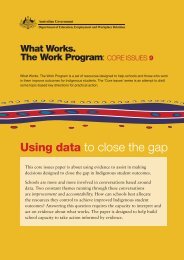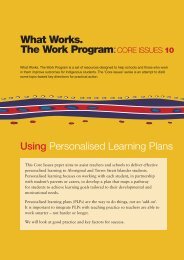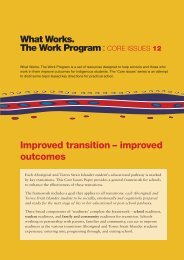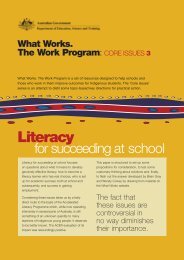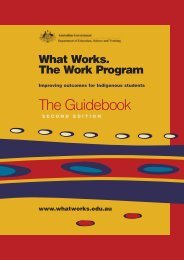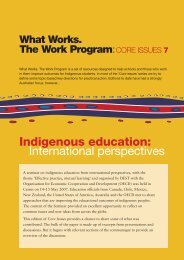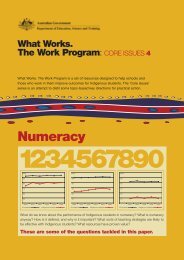Bound for Success Scope and Sequence Statements
Bound for Success Scope and Sequence Statements
Bound for Success Scope and Sequence Statements
- No tags were found...
Create successful ePaper yourself
Turn your PDF publications into a flip-book with our unique Google optimized e-Paper software.
MATHEMATICSSpaceConcept In Year 1the student:In Year 2the student:In Year 3the student:In Year 4the student:In Year 5the student:In Year 6the student:In Year 7the student:In Year 8the student:In Year 9the student:2D <strong>and</strong> 3D shapesDescribe <strong>and</strong> analyseshapes <strong>and</strong> objects <strong>and</strong>use their properties tosolve problems• Pays attention to shape inmaking <strong>and</strong> drawing things(e.g. knows that a wheel isround with no ‘bumpybits’)• Recognises <strong>and</strong> namescircles, squares <strong>and</strong>triangles in the built <strong>and</strong>natural environment• Recognises <strong>and</strong> describesfamiliar 2D <strong>and</strong> 3D shapesin the built <strong>and</strong> naturalenvironment (e.g. cones<strong>and</strong> rectangles) <strong>and</strong>represents them bydrawing, making <strong>and</strong>/orusing technology• Draws 2D <strong>and</strong> 3D shapes(using technology or byh<strong>and</strong>) from differentpositions (e.g. draws fivedrawings of a jug bymoving around the jug <strong>and</strong>viewing it front-on <strong>and</strong>from a ‘bird’s-eye-view’;Draws a box, placed on atable, from differentpositions <strong>and</strong> shows somesimple attention toperspective)• Represents <strong>and</strong> describes2D shapes in differentorientations <strong>and</strong> 3D shapes<strong>and</strong> objects from differentperspectives, highlightingrelevant features, usingtechnology as appropriate;Makes drawings or modelsthat accurately reflect thesize <strong>and</strong> significantfeatures (e.g. draws ahuman head with eyes halfway up the head instead ofat the top)• Recognises <strong>and</strong> matches a‘bird’s-eye view’, frontview <strong>and</strong> side views of a3D shape with the actualshape <strong>and</strong> explains why itis a match; Recognises <strong>and</strong>draws the net of a cube <strong>and</strong>knows that there are manydifferent nets that can bedrawn <strong>for</strong> this object• Draws the nets of prisms,pyramids <strong>and</strong> cylinders byh<strong>and</strong> or with drawingsoftware, or, given theirnets can construct theshapes using materials ordrawings; Draws squares,rectangles, parallelograms,trapezia, pentagons,hexagons, octagons <strong>and</strong>circles using theirproperties (usingcompasses <strong>and</strong>technological drawingsoftware) <strong>and</strong> paysattention to theconventions of drawingincluding the use ofperspective• Draws isometric/ front,side, top views of regularprisms <strong>and</strong> distinguishesbetween these (e.g. says“that view is an isometricview since it has an edgeclosest to me”); Drawscross-sections of regularprisms, spheres, cylinders<strong>and</strong> knows that the verticalcross-section will berepresented by a differentshape than a cross-sectionon an angle (e.g. says “thevertical cross section of acylinder is a circle but ifyou cut it on an angle youget an ellipse”); constructsa cube from its net; makesmodels of right prismsgiven their isometricdrawing-• Uses drawing tools,including geometrysoftware, models <strong>and</strong>materials to represent <strong>and</strong>construct common 2Dshapes <strong>and</strong> 3D shapes <strong>and</strong>objects includingcomposite shapes <strong>and</strong>objects; Shows front, side<strong>and</strong> top views <strong>and</strong> crosssectionsof 3D shapes <strong>and</strong>objects including simplepolyhedra, cylinders,spheres <strong>and</strong> cones <strong>and</strong>composite shapes <strong>for</strong>medfrom these (e.g. a drinkbottle) ; Draws 2D shapesto specification in terms ofboundary, angle <strong>and</strong> scale(e.g. a symbol including astar in a circle is a 5-pointed star inscribed in acircle of a given diameter);Uses geometric shapes toconstruct accurate 2Drepresentations of 3Dobjects (e.g. an isometricdrawing, front-side, topview or a single pointperspectives drawing of anhourglass, draws variouscross-sections of a toothpastetube, draws a suitablenet <strong>for</strong> constructing a coneof a given slant edgelength with a lid from asheet of paper) <strong>and</strong>discusses which propertiesare preserved by therepresentation <strong>and</strong> whichare not (e.g. angle, sidelength, area); Constructs3D objects from nets <strong>and</strong>makes models of 3Dobjects from isometricdiagrams (e.g. a soccer ballfrom the net of its stitchingpattern involving atessellation of pentagons<strong>and</strong> hexagons) <strong>and</strong>discusses their properties(e.g. what is the differencebetween two tetrahedronsjoined at their bases <strong>and</strong> anoctahedron, <strong>and</strong> which ofthese is a space-fillingshape?)In three dimensions• Sorts ‘boxes’, cones <strong>and</strong>spheres <strong>and</strong> makes simplestatements about theirdifferences (e.g. says“these boxes are long <strong>and</strong>these ones aren’t”)• Uses spatial features <strong>and</strong>characteristics to sort,compare <strong>and</strong> describecommon 3D shapes <strong>and</strong>objects (e.g. says “theseones have flat sides <strong>and</strong>corners but these havecurvy sides <strong>and</strong> they roll”)• Identifies <strong>and</strong> describes byname families of 3Dshapes (prisms, pyramids,cones, cylinders <strong>and</strong>spheres) <strong>and</strong> makesmodels <strong>and</strong> sketches ofthem• Identifies <strong>and</strong> describesfamilies of 3D shapes(prisms, pyramids, cones,cylinders <strong>and</strong> spheres) <strong>and</strong>makes models <strong>and</strong>sketches of them, <strong>and</strong> usesappropriate spatiallanguage when describingfeatures including parallel,perpendicular, vertex,edge, baseIdentifies the unique featuresof some shapes withinfamilies of 3D shapes <strong>and</strong>generalises about theirfeatures (e.g. all of the facesof triangular pyramids aretriangles; the two ends ofcylinders are circles); c<strong>and</strong>raw a 3D shape when givenan oral or written descriptionof it• Describes a 3D shape to apeer so that they coulddraw or recognise it (e.g.over the phone or inwriting) referring to theproperties of the shapes<strong>and</strong> using the correctwords to describe the faces<strong>and</strong> angles including thecorrect names of the faces)• Identifies prisms,pyramids, spheres <strong>and</strong>cylinders <strong>and</strong> describespart <strong>and</strong> composite shapes<strong>and</strong> objects in terms oftheir properties (e.g. says“that tent looks like atriangular prism so the twoends must both becongruent triangles”)• Describes features thatdistinguish one commonclass of shapes fromanother, (e.g. says “prismshave two parallel facesthat are exactly the samebut pyramids don’t”)• Identifies <strong>and</strong> classifiesdifferent representations of3D shapes <strong>and</strong> objectsincluding cylinders, cones,the platonic solids,packages <strong>and</strong> containerswith reference to faces <strong>and</strong>surfaces (e.g. atetrahedron-shapedpackage has a shape whichconsists of four equilateraltriangles, any three of<strong>Bound</strong> <strong>for</strong> <strong>Success</strong> <strong>Scope</strong> <strong>and</strong> <strong>Sequence</strong> <strong>Statements</strong> V2 Page 26 Working Document Semester One 2007





